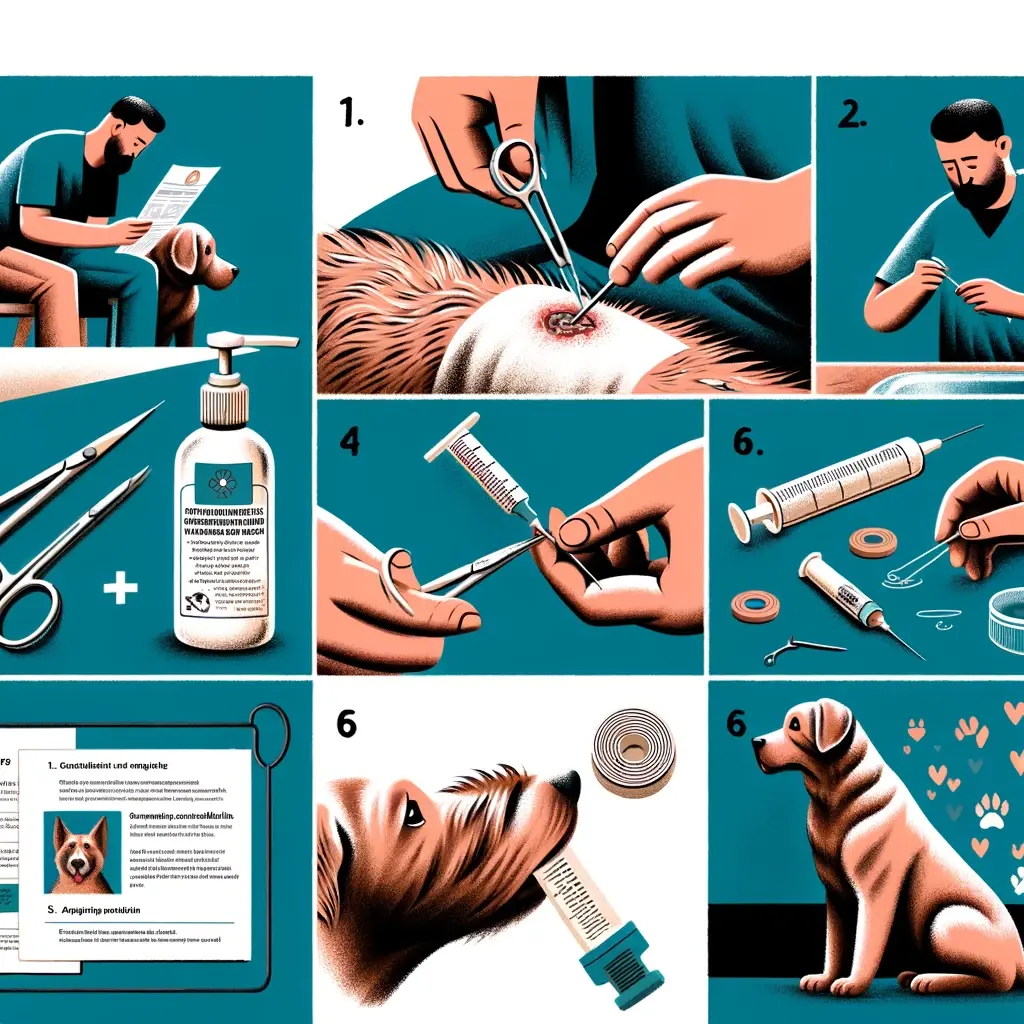Summary
To treat a dog abscess at home, first trim the fur around it. If it hasn’t drained, a vet should lance it, but for a draining abscess, gently clean the area with warm water and an antibacterial wash. Apply a vet-approved topical ointment. Warm compresses (3-4 times daily for 30-40 minutes) can aid healing. Prevent your dog from licking the area. Consult a vet if the abscess enlarges, becomes more painful, red, swollen, is larger than 1 cm, or doesn’t drain. For a ruptured abscess, clip hair, wipe pus with a paper towel, and apply a povidone-iodine solution for disinfection.
What are the Common Causes of Abscesses in Dogs?
Abscesses usually occur in the body when a part of the tissues gets affected by certain pathogenic bacteria entering through the nasal cavity and reacting with the hormones in that area.
At the same time, the immune system tries to fight the pathogenic bacteria to neutralize the toxicity of the bacteria to make everything normal inside the body.
During the entire process, the standard and bacterial flora of the dog’s body got interrupted, which caused a break in the skin barrier called an abscess in dogs.
The leading cause of abscess in the body is the movement of the white blood cells through the walls of the blood vessels at the site of infection.
It causes the build-up of fluid, bacteria, or other foreign substances, which altogether leads to the formation of abscesses in the body.
A dog can get an abscess through many means like the bite of an insect, a penetrating wound from a needle, branch sticks, grass sticks, and many other things like ringworm and superficial pyoderma can also lead to the formation of abscess in dogs.
What are the Common Abscess-Causing Bacteria in Dogs?
As we have discussed above, entering bacteria into the body through various bodily movements like breathing is the primary reason behind the formation of abscesses in dogs. Now, the bacteria that are mainly responsible for the construction of abscesses in dogs are.
Staphylococcus Intermedius
This bacteria can cause an abscess in dogs by directly inoculating the pathogen in the skin’s and soft tissues’ epidermal layer.
Pseudomonas
Pseudomonas is a type of bacteria that affects immunosuppressed pets by reacting with the bacteria in an infection of its body.
Mycoplasma
Mycoplasma is a type of bacteria that affects the pet by weakening the respiratory tract, which increases the susceptibility to viral and bacterial infections.
Escherichia Coli
E. coli is a gram-negative bacillus that obstructs the biliary system from the biliary stone or sludge, leading to stagnation and bacterial growth from the papilla or portal circulation.
Bartonella
Bartonella is a type of bacteria that affects dogs only through contact with lice, teaks, fleas, and sand fleas.
Nocardia
Nocardia affects dogs after entering the body through inhalation, ingestion, or subcutaneous transmission and then by inflammatory reactions in localized organs.
Pasteurella Multocida
Pasteurella multocida affects the dog by transmitting directly with an affected species or contaminated food and water resources.
Actinomyces
It is mainly responsible for the cause of abscesses under dogs’ skin, which develop after a traumatic injury.
Fusobacterium
Fusobacterium inhibits the intestine, respiratory tracts, and female genital tracts of the more virulent organisms, rapidly increasing infections and causing abscesses in dogs.
Clostridium
Clostridium is a type of bacteria that affects dogs after direct contact with feces or ingesting infected feces.
What are the Symptoms of Skin Abscesses in Dogs?
If a dog has an abscess, then the pet gives various responses to it, through which the owner can identify that the dog has an abscess and needs to be treated soon. The symptoms through which the owner can detect abscesses in dogs are discussed below.
- Appetite loss
- Lethargy
- Fever
- Generation of heat from the site
- Bleeding around the wound
- Excessive licking of the site
- Inflammation or swelling at the site
The symptoms mentioned above are the most common symptoms a dog owner can notice in their pet’s body while suffering from an abscess. At the same time, the specific symptoms and signs may often vary by basing on the place on the body where the abscess is located.
For example, if a dog has an abscess near the joints, it will suffer from limping and movement problems due to the joint pain.
How to Treat an Abscess on a Dog at Home?
It was suggested to most dog owners that an experienced veterinarian should treat the abscess of a dog, but if the type of abscess the dog is suffering from is not that serious, it can also be treated at home. The steps that a dog owner can follow for home treatment for the abscess of a dog are discussed below.
Cut the Hair
The first step that the dog owner should follow while treating an abscess of the dog is to cut the hair around the site of infection to see it properly. This will help the owner to adapt the treatment procedure quickly.
Inspect if the abscess has been Drained.
Secondly, the owner should check whether the dog’s abscess is draining.
This is because the draining of an abscess is a sign that it will heal soon. If the abscess is not draining, the owner should keep it as it is until it starts draining.
Use a Sterilized Needle
A dog owner shall use a sterilized needle to lance the abscess, as lancing is necessary for healing the abscess from the inside.
For this, all the owner can do is take the affected area between the fingers and try to squeeze it by licking, then use a sterilized needle to make the abscess drainage fast. This is also the top home remedy.
Use an Antibacterial Wash
After thoroughly cleaning the abscess drainage, the owner has to choose an antibacterial wash per the sensitivity of the dog’s skin and then apply it over the affected area to rinse off all the dirt material and dog wounds to clean the abscess.
Use of Ointment to the Dog Abscess
After following all the above processes, the owner can use medication like an ointment over the abscess to treat it faster. When choosing the ointment for the dog, the owner can consult with the vet to check what type of skin the dog possesses and what ointment is best for it.
Warm Compression
Applying warm compression can help treat the abscess of the dog. The owner can take some hot water and a piece of cloth, dip the fabric in the water, rinse the excess water, and apply it slowly over the affected site.
Regular use of this for about 30 – 40 minutes daily, 3 to 4 times, will work wonders in treating abscesses in dogs at home.
These steps are entirely safe, and a dog owner can fully rely upon them to treat their dog’s abscess at home, as it is based on research done by cynologists on the treatment process of abscesses in dogs.
When Should You Visit the Vet?
The conditions when a dog owner should go for a center dog care to treat the dog’s abscess are discussed below, in case home remedies don’t work.
- If the abscess continues to enlarge and becomes more painful.
- If the infection starts becoming red and gets swollen.
- If the length of the abscess is more considerable than 1 cm.
- If the abscess is not draining after your proper care.
All the above-discussed methods require a quick vet visit or a dog care center.
How to Clean a Ruptured Abscess in Dogs?
Sometimes, the abscess can rupture before reaching the veterinarian, where some first aid treatments are required to treat the abscess and prevent the situation from worsening.
If the abscess gets ruptured, then it needs to be cleaned rapidly. Steps that a dog owner can follow during this situation are:
Clip the Hair
The owner shall clip the hair to clean the ruptured abscess for frequent cleaning.
Use a Paper Towel
The use of a paper towel or cloth is necessary to wipe away the pus around the site.
Use of Iodine Solution
After cleaning the ruptured abscess, the owner should apply the povidone-iodine solution to keep the abscess site disinfected to keep site disinfected.
The above-discussed steps are very efficient in cleaning a ruptured abscess in dogs. So, a dog owner can entirely rely upon these steps to clean a ruptured abscess.
So, that’s all about what steps to follow when you want to treat a dog abscess at home, which will relieve them. We hope the article has ended your question search regarding how to treat an abscess on a dog at home.


